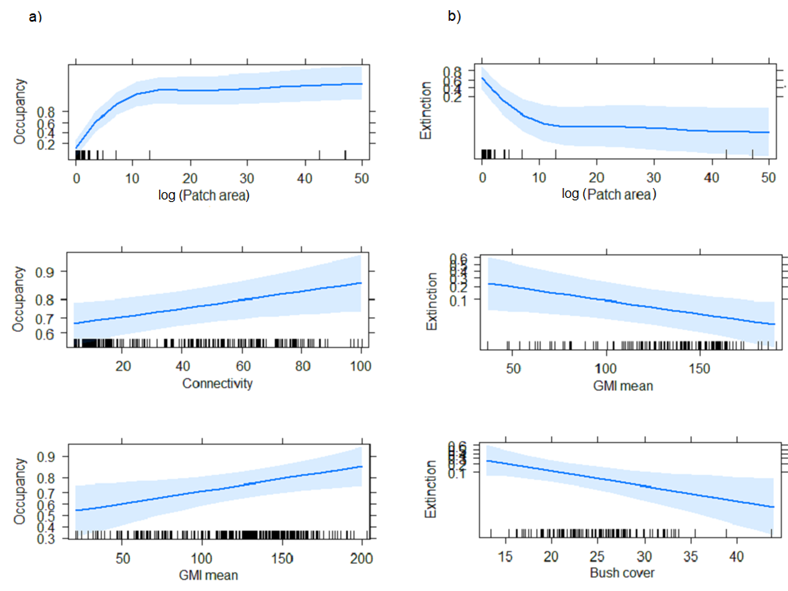Species occurrence
The marsh fritillary was present in 129 of the 256 suitable habitat patches. Between the years 2020 and 2021 35 patches have been colonized and in 30 areas local extinction has occurred.

The occurrence probability increased with increasing patch area, connectivity and GMI (ground moisture index). The extinction probability decreased with larger patches, high GMI, and an increase in bush cover. None of the variables, patch area, connectivity, GMI, bush cover and tree cover explained colonization. Patch area was the variable with the strongest influence according to the AIC.

Estimation of the population size
In the four areas of capture-mark-release (CMR) survey, site C held the largest population, followed by site D, A and B. Site A was the largest area surveyed and had a larger number of unique individuals -i.e. not recaptured specimen. Site B had also many surveyed grids, however had the smallest number of unique individuals. Even having the largest populations, site C and D were the smallest areas, and held 795 and 620 unique individuals, respectively.
| Estimation of population size | Number of grid cells | Habitat area (ha) | Density per hectare | Unique Individuals | |
| Site A | 2683.97 | 67 | 27.67 ha | 97 | 1141 |
| Site B | 223.088 | 40 | 15.38 ha | 15 | 93 |
| Site C | 2909.72 | 12 | 10.16 ha | 286 | 795 |
| Site D | 2735.58 | 19 | 16.79 ha | 163 | 620 |
Nectar survey
The results showed that nectar use is not opportunistic, so there are species that are present in the area but that were not chosen by marsh fritillary. Here you can see a list o the flowering species present and how much they were used by the butterfly.

Larvae occurrence
In the small-scale analysis, 328 nests were found in a total of 2000 sampled points. The most informative model explaining the occurrence of larvae included (length of the biggest leaf of the) host plant size, vegetation height, presence of tussocks, number of stalks, and vegetation cover. Areas with plants with larger leaves, short vegetation, tussocks, more stalks in the host plant, and less vegetation cover are beneficial for the presence of larvae. The three most important variables were size of the max leaf, number of stalks, and vegetation height based on AIC.

On a larger scale, the presence of the larvae was influenced positively by habitat area, GMI and bush cover, and negatively by grazing. Habitat area was the variable that had the strongest influence in the final model, followed by grazing, according to AIC.
